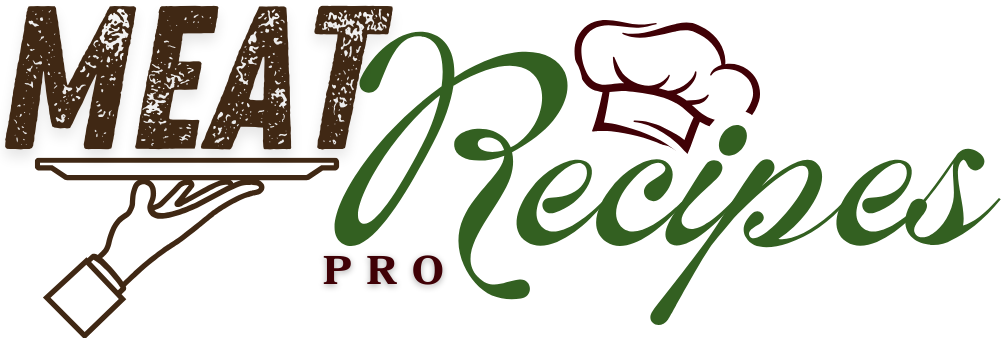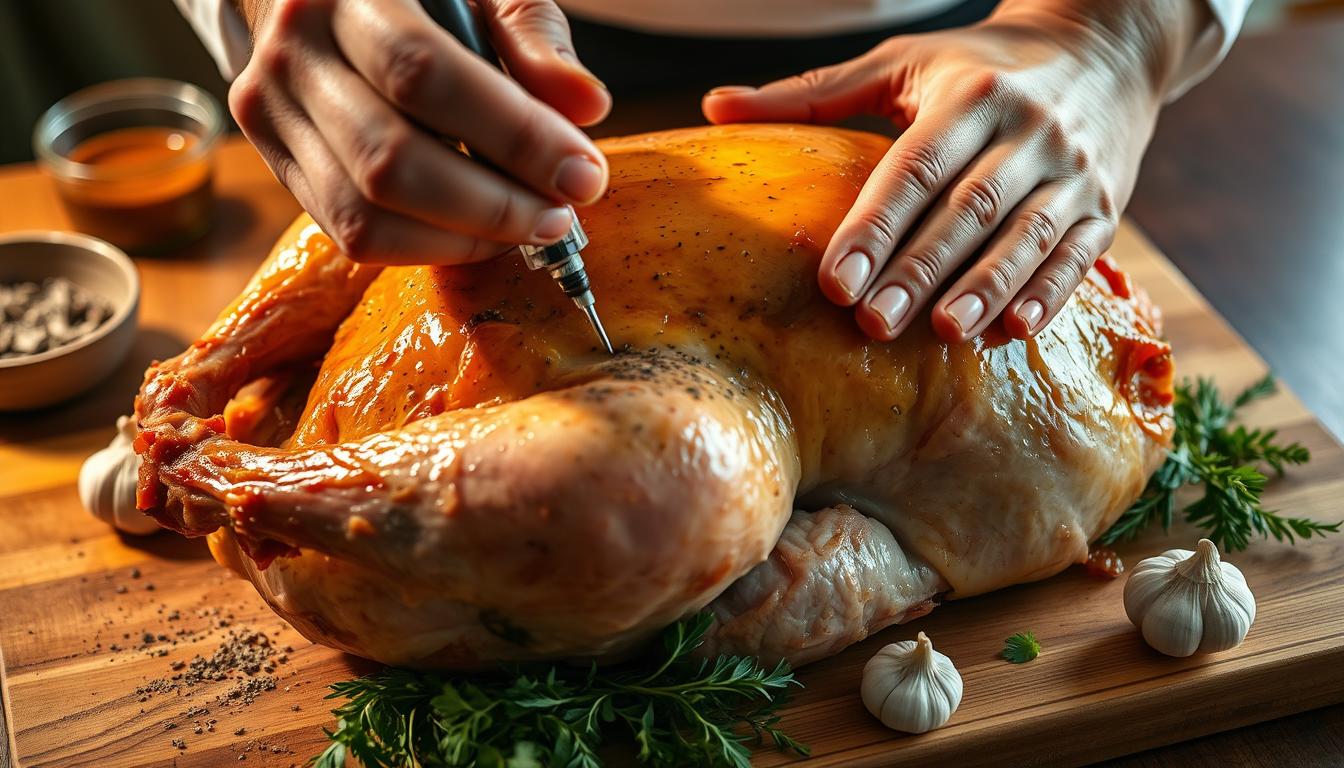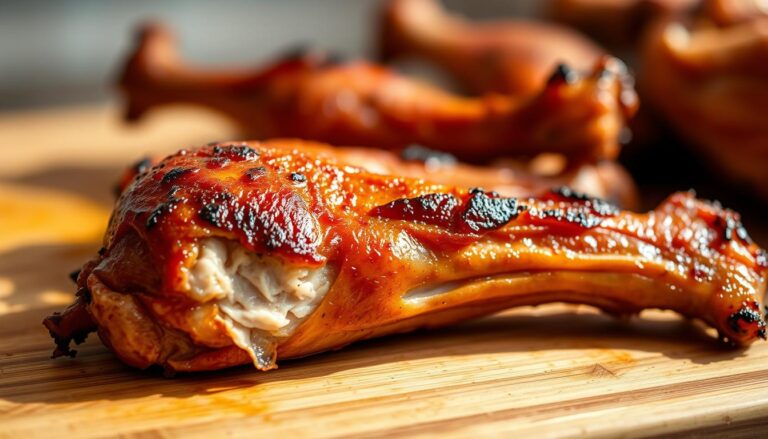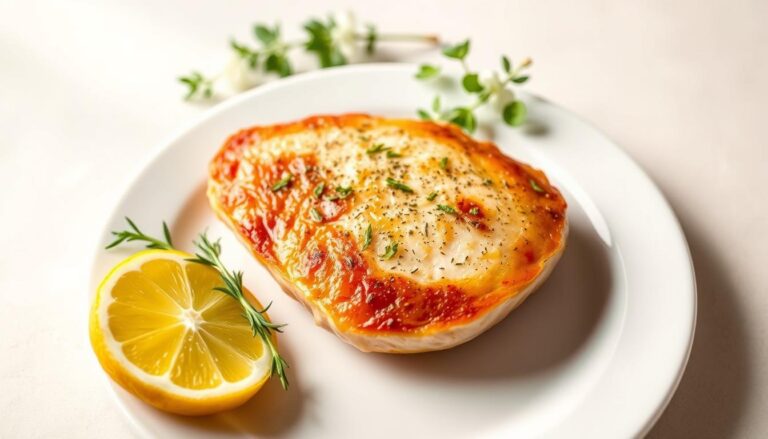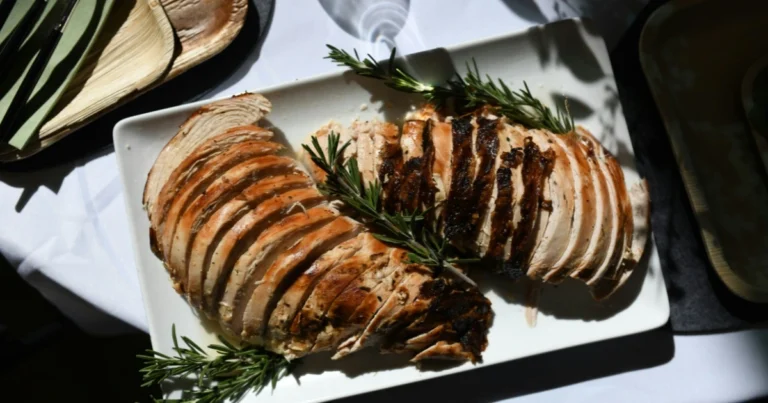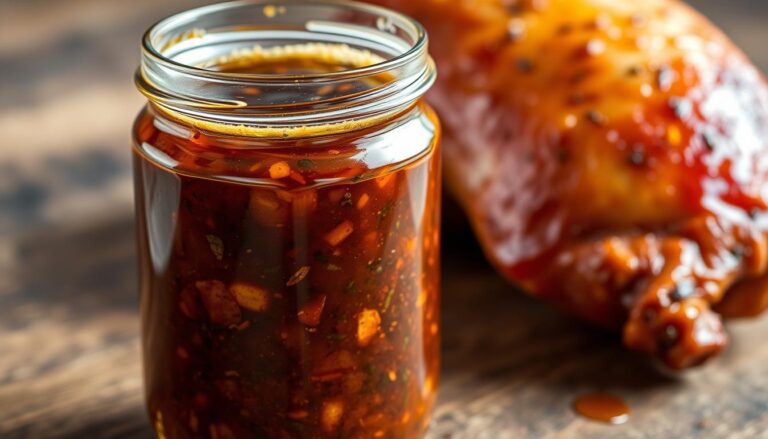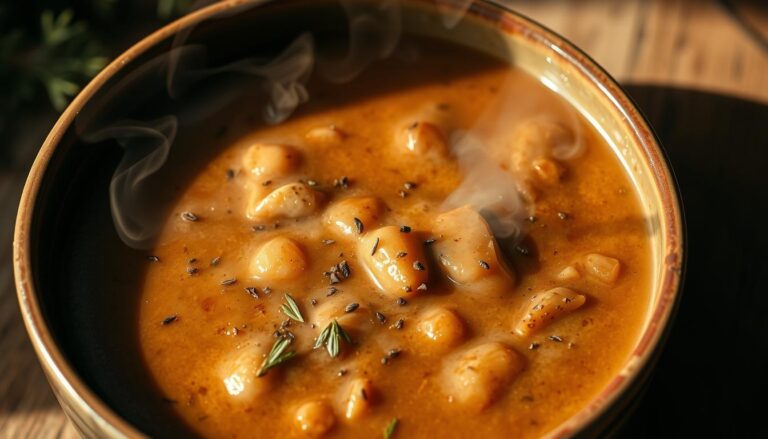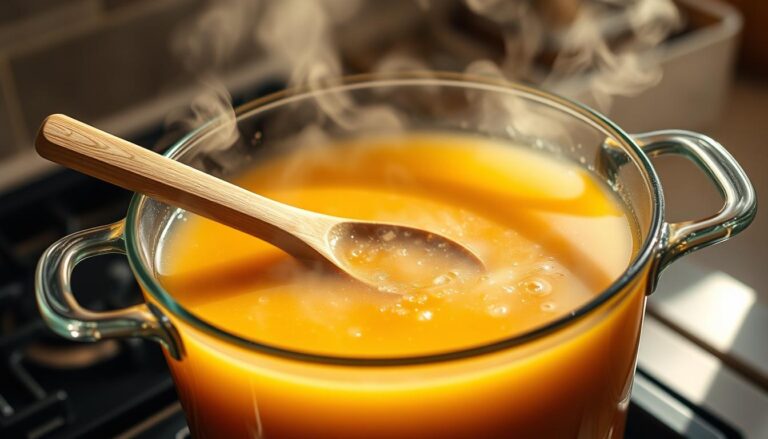Homemade Turkey Injection: The Key to Moist, Delicious Turkey
You want a bird that tastes like care, not compromise. On Thanksgiving or any roast day, nothing beats the quiet pride of serving slices that stay juicy to the bone. This introduction shows you a simple, fast way to lift your roast and control every note of flavor.
Skip the pricey, high-sodium bottles from the grocery store and use a quick beer-based recipe you can whisk in minutes: 12 oz light beer, 2 Tbsp Worcestershire, 2 Tbsp honey, 5–6 drops hot sauce, and 1 tsp coarse Kosher salt. Strain, keep spices fine, and use a stainless injector for the best power and no clogs.
This way you get even seasoning from edge to center without days of prep. You’ll learn when to inject versus brine or marinade, how to treat breasts and thighs, and a bolder Cajun option when you want extra zip.
Table of Contents
Why You’ll Love This Homemade Turkey Injection
This quick method pushes seasoning and moisture deep into the bird so you get juicy meat without long brining times. It saves you valuable time and still delivers restaurant-style results at home.
Moisture and flavor without long brining
An injection puts moisture and seasoning inside the meat in minutes, not overnight. You can inject just before cooking, which is perfect when your schedule changes or you start late.
Customizable to your family’s favorite flavors
You control salt, heat, and sweetness. Use light beer for malty notes or low-sodium broth for a neutral base. Thin hot sauce adds warmth without clogging the needle, and honey or agave gives a soft balance.
- You get juicy results fast—seasoning reaches the center of the meat quickly.
- Scale salt to match dietary needs while keeping the same tender texture across the whole bird.
- Layer citrus or umami—lemon or Worcestershire—so the mix tastes bright and complex.
- Keep spices ultra-fine so the mix flows smoothly and injects evenly into breasts and thighs.
These choices let you rerun favorite recipes and tweak them each year so your signature roast gets better and more consistent.
What Is a Turkey Injection and How It Works
Think of an injection as an internal baste that works while the bird cooks, keeping slices juicy and seasoned. Instead of relying on surface soaking, you deliver seasoned liquid directly into the meat so the center tastes as good as the outside.
Injection vs. marinade: getting flavor past the surface
A typical marinade only soaks about 1 cm into the flesh. An injection carries flavors and fat past that barrier.
The result: the interior bastes from within as the bird roasts, so breasts and thighs stay moist.
When an injection beats brining for busy timelines
If you forgot to start a brine or need a fast way to flavor a whole turkey, an injection is the practical option.
You can make about 1–2 cup of liquid for a whole turkey and inject up to 24 hours ahead or moments before cooking. Use a butter- or broth-based mix with garlic, citrus juice, and bouillon paste for savory depth.
| Benefit | Why it matters | When to use |
|---|---|---|
| Deep seasoning | Flavors reach the interior of the meat | Short prep time or no brine |
| Internal basting | Moist slices without added steps | Roasting, smoking, or frying |
| Flavor control | Add garlic, citrus, or Cajun spice | Weeknight chicken or holiday roast |
Homemade Turkey Injection Ingredients You’ll Use
Pick a base liquid first; it’s the backbone of the flavor you’ll taste throughout the bird. Choose between a light beer, low-sodium chicken broth, apple juice, or apple cider to set the tone.
Base liquids
Light beer adds a gentle malt sweetness. Low-sodium chicken broth keeps things savory. Apple juice or apple cider bring a mild fruit note.
Flavor builders
Layer in 2 Tbsp worcestershire sauce for umami, 2 Tbsp honey for balance, 5–6 drops thin hot sauce for heat, and a splash of lemon juice to brighten.
Seasonings that won’t clog your needle
Use soluble powders: garlic powder, onion powder, and finely ground creole seasoning. Grind flaky spices so the needle flows smoothly.
“Whisk well and strain: undissolved salt crystals and chunks are the main reason injectors clog.”
Butter or oil considerations
Fat adds richness, but melted butter or oil can leak from injection sites and burn on fried birds. For frying, avoid fat-based mixes. For roasting, reserve butter under the skin instead.
| Ingredient | Why use it | When to avoid |
|---|---|---|
| Light beer | Malty sweetness and depth | If you want purely savory results |
| Low-sodium chicken broth | Neutral savory base, predictable salt | If you need sweeter notes |
| Apple cider / juice | Light fruity sweetness | When avoiding sugar on the skin |
| Butter / oil | Rich mouthfeel when used under skin | Frying or when avoiding splatter |
Core Turkey Injection Recipe (Quick, Simple, Flavorful)
This core recipe gets flavor and moisture deep into the bird with a quick whisk and no heat. It takes only a few steps and about three minutes to mix. Use light beer or low-sodium broth as the base to match the profile you want.
Whisk-and-go method:
- Combine 12 oz light beer (or 1 cup low-sodium broth), 2 Tbsp worcestershire sauce, 2 Tbsp honey, 5–6 drops thin hot sauce, and 1 tsp coarse Kosher salt.
- Whisk in a bowl for about 3 minutes. Do not shake carbonated beer in a sealed jar — it will foam.
Strain and prep for a smooth flow
Strain the mix through a fine mesh to remove any grit or undissolved salt. Fully dissolve the coarse salt so you avoid pockets of brine inside the meat.
How to inject: Load the injector, pull the plunger slowly to avoid aeration, and insert the needle deeply into breasts and thighs. Press the plunger as you withdraw so liquid disperses along muscle fibers.
“Plan about 1/2 ounce per 5 lb as a baseline; add extra passes from different angles for even coverage.”
Wipe any small leaks — slight seepage is normal. Keep leftover mix chilled and warm it slightly toward room temperature before reusing so the needle flows smoothly if you need to inject turkey again.
Cajun Turkey Injection Variation
If you want a zesty holiday twist, craft a Cajun base that balances butter richness with bright lemon and spice.
Build a Louisiana-style flavor base
Start with melted butter and a touch of oil so the mix carries through the needle. Add hot sauce, fresh lemon juice, and a solid pinch of creole seasoning for depth.
Spices and flow-friendly ingredients
Use finely ground garlic powder, onion powder, and ground thyme so your injector won’t clog. A small pinch of crab and shrimp boil seasoning adds that authentic bayou note.
- Balance heat with acid and salt; taste the mix before you load it.
- Inject breasts and thighs from multiple angles so the bold flavors spread through the meat.
- If time allows, let the bird rest covered an hour, then reinject any liquid that seeped out.
“Reheat chilled mixes until the butter is liquid again for a smooth, even flow.”
Storage tip: Butter-based mixes freeze or refrigerate well. Rewarm to melt the melted butter before using.
Tools You Need to Inject Turkey Like a Pro
A few solid tools make the difference between a messy attempt and a confident, clean injection.
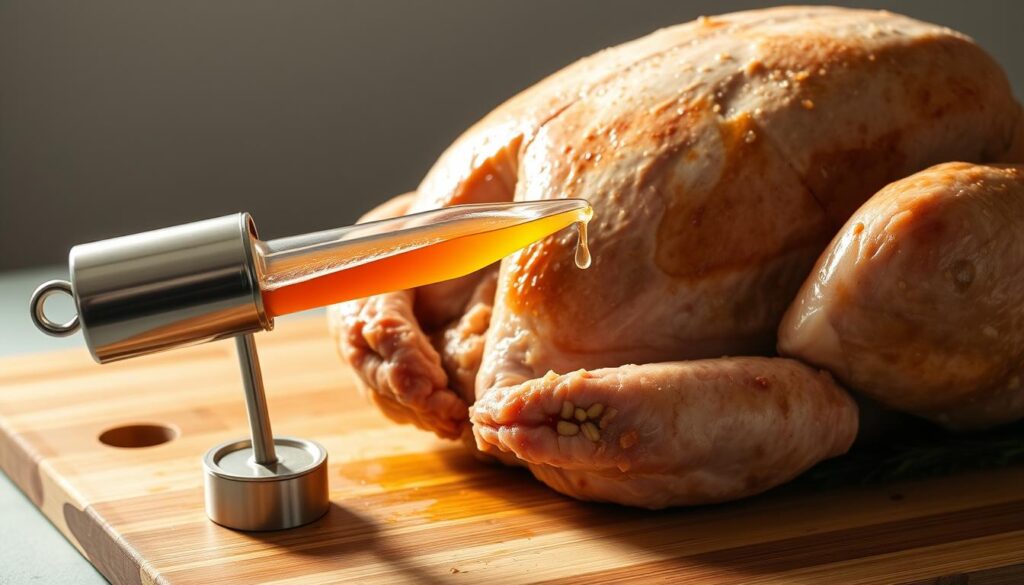
Choose a stainless steel injector for durability and dishwasher safety. Heavy-duty metal models push through dense meat with steady pressure and last longer than plastic alternatives.
Needles and seals
Keep multiple needle options on hand: a single-hole needle works best for thin liquids, while multi-port needles spread liquid more broadly.
Stock extra rubber O-rings or washers. They wear out and cause leaks; replacements keep your tool sealing tight during busy cooking days.
Mixing and prep gear
Use a deep mixing bowl and a fine mesh strainer to smooth liquids and remove particles that clog the needle.
Load the injector from a tall, narrow vessel so you can pull the plunger smoothly and avoid trapped air bubbles.
- Test flow: draw a small amount to confirm smooth delivery before the first shot into the turkey.
- Keep cleanup simple: disassemble and wash immediately so spices and fats don’t harden inside.
- Workstation tips: paper towels, a dedicated cutting board or roasting pan, and a labeled container for injection-only tools make the process tidy and repeatable.
“A good injector and a clean habit are the shortcuts to consistent results across recipes.”
How to Inject Turkey Step by Step
Start with temperature and placement in mind, and each injection will reach the meat where it matters most.
Prep your bird: Thaw a frozen turkey fully in the refrigerator. Set it out briefly so the surface loses its chill before you begin.
Place the bird in a roasting pan to catch drips and protect your counter. This keeps the work area tidy as you load and shoot the mixture.
Load the syringe and prime the needle
Load the injector with your cooled liquid and tap out air bubbles for a smooth first press. Draw slowly to avoid aeration and keep the flow steady.
“Insert the needle deep into the breast, withdraw slowly while pressing the plunger, and repeat from different angles for even coverage.”
Inject breasts, thighs, and other meaty areas
Insert the needle deeply into the turkey breast, then draw back slightly while pressing the plunger so channels fill along muscle fibers. Repeat on the second breast.
Move to thighs and other meaty zones, steering clear of bones that block flow. Change angles at each site to spread the liquid instead of pooling it.
Technique tips and finishing steps
- Apply steady, slow pressure on the plunger; rushing forces liquid back out of the entry point.
- Wipe minor leaks—some seepage is normal as the mix redistributes through the meat.
- Keep the injection at cool room temperature so the needle flows easily and won’t clog.
- When finished, wash the injector and sanitize surfaces before you cook turkey to 165°F in the thickest part of the turkey breast.
| Step | Why it matters | Result |
|---|---|---|
| Thaw fully in refrigerator | Prevents uneven thawing and bacterial risk | Even texture and safe prep |
| Prime needle and remove bubbles | Smooth, controlled delivery | Fewer blowouts and consistent pockets of flavor |
| Inject deep and change angles | Distributes liquid through muscle, avoids pooling | Juicier slices from breast to thigh |
| Sanitize after use | Prevents cross-contamination | Safe handling and clean tools |
Timing: When to Inject for Roasting, Smoking, or Frying
When you choose the right moment to add flavored liquid, the result is a more consistent, juicy bird. Timing affects browning, flavor penetration, and how the meat holds moisture during the cook.
Right before cooking vs. up to 24 hours ahead
Inject right before cooking when you’re short on time. The liquid will baste the interior as heat rises and give an immediate boost of flavor.
Inject up to 24 hours ahead if your schedule is tight. Keep the whole turkey refrigerated and leave the skin uncovered so the surface browns better in the oven.
Special note for fried bird
For frying, inject immediately before you lower the bird into hot oil. Pat the skin thoroughly dry first to reduce splatter and help the skin crisp.
- Plan more liquid for a whole turkey and less for a turkey breast to avoid waste.
- For smoking, inject early so flavors settle during the long cook.
- Taste a Cajun turkey mix first; adjust heat before you inject turkey to suit guests.
- Keep your mix cool and fluid; never inject hot or congealed liquid.
“Always cook turkey to an internal 165°F, checking the thickest part of the breast for safety and juiciness.”
Brining and Injecting: Should You Do Both?
Combining a brine and a flavored shot can work, but it requires a careful eye on salt and balance. If you try both, the main risk is an overly salty finish. A well-brined bird may also push liquid back out where the needle entered.
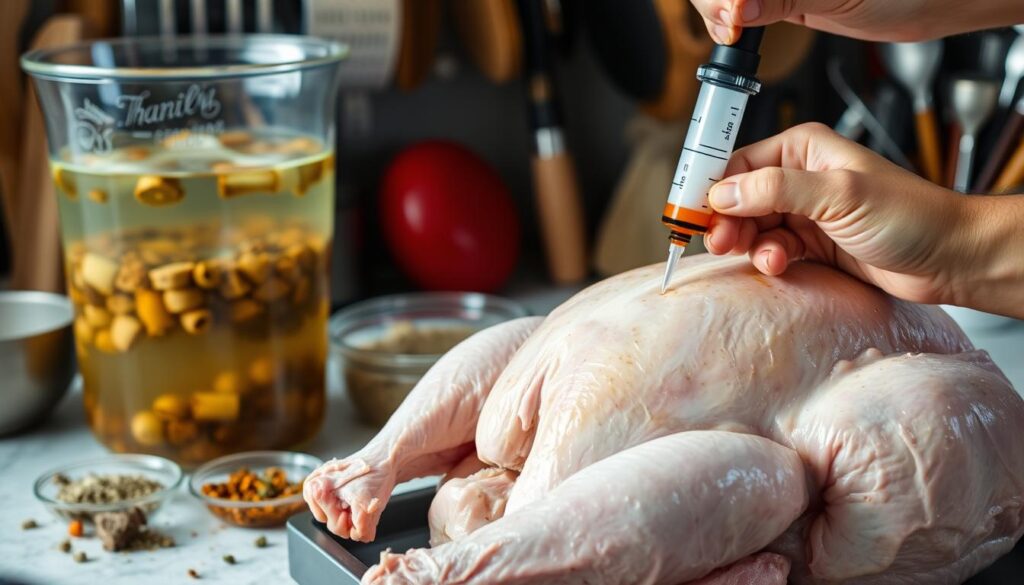
How to reduce salt if combining methods
Cut salt in your shot so the sum of brine plus injected liquid stays balanced. Match the flavors: if your brine is herb-forward, choose a complementary, low-salt liquid for injection.
When brining alone or injecting alone makes more sense
Choose injecting alone when you don’t have time for a soak. It’s the fastest way to get flavor into the meat and is ideal the day of the roast.
Use brining alone if you want a set-it-and-forget-it method and broad, even seasoning without extra steps.
- If you use both, reduce salt in the shot and inject modestly into breasts and thighs.
- Keep surface rubs lighter when brine and shot both carry sodium.
- New to this? Pick one way first, note results, then refine your turkey injection recipe next time.
“When in doubt, favor balance: less salt in the injection keeps the meat from tasting sharp.”
Flavor Ideas to Make It Your Own
Use the mix as a starting point and tweak it to match your table’s tastes. Small changes in sweet, savory, or bright components make big differences during a long roast or smoke.
Sweet‑savory combos
Try apple cider with a touch of honey or brown sugar for rounded sweetness that won’t dominate the meat. Use just enough to balance, not sweeten.
Savory boosts
Better Than Bouillon or a concentrated bouillon paste adds deep umami without adding grainy particles. Stir in dry mustard, thyme, or sage for classic holiday depth.
Bold and tropical twists
Bourbon, pineapple juice, or a teriyaki-inspired sauce give you a creative riff. Strain these blends well so fibers and fruit bits don’t clog the needle.
- Use chicken broth as a neutral base to let herbs and spice shine.
- Add lemon juice and Worcestershire for brightness during long cooks.
- Spice gently with thin hot sauce, cayenne, and a pinch of black pepper; taste as you go.
- For a bayou note, fold in a bit of cajun turkey injection flavor via Creole seasoning.
- Record favorite combinations as repeatable injection recipe versions for next time.
| Profile | Key ingredients | Why it works |
|---|---|---|
| Sweet‑savory | Apple cider, honey, brown sugar | Rounds acidity, adds caramel notes without overwhelming |
| Classic savory | Chicken broth, Better Than Bouillon, thyme, dry mustard | Deep, balanced backbone that amplifies other ingredients |
| Tropical/umami | Bourbon, pineapple juice, teriyaki sauce | Unique caramel and tang that pairs well with roasted meat |
“Keep solids finely ground or fully dissolved so the syringe flows and flavors distribute evenly.”
Turkey Injection Recipe Safety and Best Practices
Handle your flavored liquid like any perishable ingredient: cool it, strain it, and keep it away from ready-to-eat items while you work.
Cooling and flow: Chill your mix to about 70–75°F before loading the injector so it flows smoothly and does not congeal in the needle. Avoid hot liquids; they can damage tissue and make results uneven.
Strain, sanitize, and prevent clogs
Always strain spices and solids. Fine seasonings move through the syringe and distribute through the meat without jamming the needle.
Treat the injector and workstation as raw-poultry zones. Sanitize bowls, counters, and tools after use, and wash your hands regularly during prep.
What to discard and what you can brush
- Discard any leftover mix once the needle has contacted raw turkey to avoid cross-contamination.
- If the blend is butter-based, you may brush it onto the skin immediately instead of reusing it.
- Keep paper towels handy to dab small leaks and avoid spreading juices.
- Thaw a frozen turkey fully in the refrigerator and keep it below 40°F until you begin.
“Use a calibrated thermometer and confirm 165°F in the thickest breast area before resting.”
Final tip: Season lightly with pepper and check one last time that your tools are clean before cooking to protect flavor and safety.
Serving, Gravy, and Leftovers
Save the pan drippings from your roast—they’re the fastest route to a gravy that actually tastes like the meat. Skim off excess fat, then whisk in flour to form a roux. Slowly add chicken broth or plain broth until the texture is silky.
Using drippings to make gravy
Start hot: pour drippings into a saucepan, remove most fat, and stir in 1–2 tablespoons flour. Cook briefly to remove the raw flour taste.
Whisk in chicken broth a little at a time to reach your preferred thickness. Taste and adjust salt and pepper with the roasted meat.
“Use about 1 cup of gravy per 4–6 servings as a starting point; scale for larger gatherings.”
Breast vs. whole bird cook times
Expect a turkey breast to hit 165°F faster than a whole bird. Always confirm with an instant-read thermometer at the thickest point.
| Cook style | Estimate | Check |
|---|---|---|
| Boneless breast | 1–1.5 hours | 165°F at center |
| Whole bird | 2.5–4 hours (size dependent) | 165°F in thickest breast |
| Rest time | 10–20 minutes | Juices redistribute for cleaner slices |
Storing leftover mixes and reheating
If you made extra butter-based injection mixes, refrigerate or freeze them. Reheat gently until the butter is melted butter again, then strain before reuse.
Discard any mix that touched raw meat. When reheating carved slices, add a splash of broth or a few minutes under low heat to keep meat tender.
- Let carved slices rest a few minutes for moister cuts.
- Save leftovers for sandwiches, soups, and other recipes.
- Record cook times for your oven or smoker so you can cook turkey more precisely next time.
Conclusion
Finish strong: a well-made homemade turkey injection is a fast, affordable way to lock in moisture and steady flavor through the breast and thighs.
You now have a reliable turkey injection and a go-to injection recipe that beats pricey, salty grocery store bottles. Strain, cool, and load carefully so needles stay clog-free.
Pick a quick base or a bold cajun turkey injection twist, inject just before cooking or up to 24 hours ahead, and roast, smoke, or fry with confidence.
Tip: balance salt if you combine brining and this method, watch temperatures, and rest the bird for juicy, memorable slices at your next thanksgiving turkey service.
